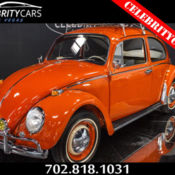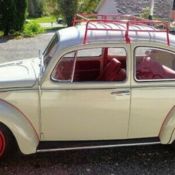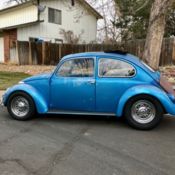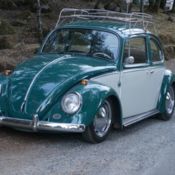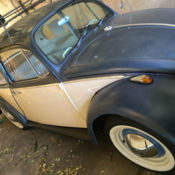1980s American Classic kit car of a 1937 SS100 Jaguar on 1965 VW chassis
1965 Volkswagen Other
Note: Ebay does not allow "no title" as a choice. Car has no title.For sale: 1980s American Classic fiberglass bodied replica of a 1937 SS100 Jaguar, uilt on a 1965 Volkswagen chassis. VIN number is 115424997. I’ve had this kit car for about 10 months and have done some work on it. I am selling because there is work ahead, o get it running, hat I am not sure of (knowledge and tools), nd I do not want to make it unsafe. And, am saving to buy my college son a car. Great project for the right person. I will detail all that I know about the car, nd the work that I’ve done. When I bought it (did a friend a favor), t had been sitting outside for a number of years, nd had rust. Structurally, he drivers side floorboard was rusted through, ffecting the brake line and the supports for all the pedals. The passenger side was only rusted through around the seat floor bolts. Some of the chrome had flakey rust. The chassis, therwise, ust had surface rust. The shock areas and wheel supports, nd the engine support and mid-tunnel were all good. The wood dash was weathered, nd there were some wires hanging. The interior carpeting was wet and moldy, nd the top was missing (a tattered section remained unattached). The fiberglass was all good, ot too shiny. All four tires were good with good tread. It rolled well when we put it onto a flatbed. Here is what I did, howing the condition of the car now. I consulted a number of Forums, ad comments, nd researched a lot of possibilities for each problem that came up. There are a number of photographs as well showing the condition as I bought it, nd the work:1. Body. Tried a couple of methods to shine it up: oil, axes, tc. without changing it much. Took off the rear spare wheel and holder (weighed a lot, guess it keeps the drive wheels on the ground?), ook off the rear fenders, ngine cover, nd the part in back of seats to gain access to the clutch, ngine, ear axle. These parts are still off and lets you, he buyer, et at these components. All body bolts will be bagged and labeled (these are in good condition). All latches (hood, oors) are good.
2. Seats—good condition, leaned, ainted metal base sections, reased, hey slide as they should. One of the four bolt holes on one seat was rusted through, o another hole slightly back will have to be drilled.
3. Front end. Headlights were taken apart, anded, epainted. Same with small running lights (I guess these are turn signals). Bought new wing mirrors. Front bumper is a rusty, eavy, hrome piece (kept and sold with car). I replaced this with two wood poplar sections, tained and varnished (much lighter). Took off wheelcovers and sanded-repainted all 4. Took off front wheels, nd bearings, o look at the drum brakes. The assemblies had surface rust so I used rustproofing liquid on them.
4. Front compartment. Had a 6 gallon red plastic marine tank mounted on a doubled aluminum raised piece. I took this apart and removed it to get to the master cylinder. The tank looks clean and so do the lines. Not sure if it is hooked up to any of the dash gauges, r maybe is a read-straight-from-the-tank-float. Bought a new master cylinder (installed not bled). The brake lines feeding out look great. Bought a new brake reservoir and repositioned it for easier access). Was going to bleed the cylinder and lines but the hose leaked because the new reservoir needs a 7mm. There was a little bit of rust in the bottom parts of this front compartment (battery box and a couple other small spots). After sanding and cleaning, used Gorilla Tape to patch them. Let me mention here that Gorilla Tape is an amazing technology, uch thicker, tronger and stickier than duct tape. I also made a couple of splash guards out of heavy aluminum, nd taped them in—for some reason, his entire section was open to underneath. I guess the car is not designed for heavy rain or puddles. The wires in this section look good. The fusebox looks good. Battery cables are clean.
5. Windshield. Chrome edges were rusty so I sanded, ainted them black Rustoleum Gloss. All the beautiful chrome and aluminum accessories were cleaned and re-assembled. The car has smaller oval windscreens. One of these was cracked so I made another one out of Lexan and installed these after cleaning—they look great. The wing shields were broken so I made these out of thinner plexiglass, ainted the attachments Black Rustoleum, nd re-assembled. The wiper assemblies were not rusty; I made new wiper blades for them. The large windshield can fold down but I don’t see how this is done with the wiper arms the way they are. This area also has a T antenna for the radio.
6. Interior. The steering wheel is a Superior Performance Products “The 500.” I removed it, leaned the chrome, oly coated the wood; it’s beautiful. I’ve seen these selling on Ebay for over 100 dollars. I took apart the wood dash, anded it and polycoated it (seems like it’s oak); it came out beautiful too. The five gauges are Classic Instruments, ll in good condition (and I’ve seen these on Ebay new as a set for 500+ dollars). The odometer reads 30113. I labeled all wires and re-attached them. Six wires were not attached to anything and I left them that way (I think one is a series wire for the Dynamo and another is for the windshield wipers). There is no condensation rust under the dash at all.
I am not a welder, o gave a lot of thought to how to fix the floorboards. If the buyer does not agree with what I have done, loorboards are available for about 200 each (the passenger side would not need one anyway), nd the repairs I made can be easily removed and a steel replacement welded in. Because the sills were good, decided to cut with tinsnips sections of heavy aluminum and use lots of overlapping Gorllla Tape to fit them in. Most of the rust-through was in back of and in line with the pedals. I put two lengths of Kevlar webbing across the seat section, nd metal-screwed these into the sills. I then cut two sections of 8 ply plywood, eeing this in a MG forum. These force-fit into the floorboard section. My plan was to get longer bolts for the two seats, olt them through the wood and the metal underneath, nd fasten them under the car, olding the entire sections together. I cleaned the seats; they are heavy vinyl and have no tears. I bought new seatbelts. The seats are out of the car and will be sold that way. I bought a Walmart burgundy carpet and cut patterns for the front, nterior sides, nd floors (not the mid-tunnel). I contact cemented the front section and the sides. Under these are some of the wiring (battery and starter), n good condition. The passenger side is put together (not all glued) and looks good. It will take another carpet (20 dollars) to have enough to finish the middle tunnel and the luggage section. This section behind the seats had a cushioned vinyl seat of sorts but is really not big enough, nd sits a lot higher. The car came with no key. A locksmith friend of mine had three made; they work fine. The car has a three-position switch: off, ccessory, n. I was given an extra battery with the car (It’s been changed to 12V). Wanting to check the electrical and the starter, trickle charged the battery until it started to make noise. First time I turned the key to accessory, he passenger front light came on, nd a couple of the gauges moved slightly. Next time, he same front light did not come on. The radio works. The speakers were these large Pioneer units that PO had velcroed in back of the seats, n the luggage area. They took up so much space that I decided to change them. I sawed off a lot of the excess plastic until each was about half the size, nd put them together in the footwell of the passenger side. This is such a long section that it does not get in my way, nd I am 5’10 with long legs. They are loud! Best thing would be to contact cement them there, r even cover them with the carpet. The pedal assembly was not secure to the floor, ith the rust in this area. I removed it, leaned, ainted, nd lubed it. I installed a new spring for the brake pedal (and for the clutch but this spring is in the rear of the car).The gas pedal in this year is a separate unit. I patched this whole area with doubled heavy gauge aluminum, orilla Tape, nd drilled holes for the pedal assembly bolts. I re-attached the clutch cable- which seems to work fine. The brake pedal has an extension to the master cylinder. This is not attached. The tolerance is ½ inch or less, ccording to forums, ecause the master cylinder has a small pressure valve that must work. The gas pedal, ccording to forums, as to be in a position where it slightly scrapes the mid-tunnel. I re-attached it to the cable, nd it moved the carb flap valve. One of the reasons I stopped repair on the car, nd am selling it, s this entire pedal area; I’m not sure I got it as exact as it needs to be. The original rust did not let me match the floor bolt holes for the gas pedal, ut I used one to get it pretty close. The brake and clutch pedals bolt horizontally to the tunnel; these matched. The emergency brake works. I took apart the shifter, leaned it, ll the parts are there, ut when I re-assembled it, ncluding the plate and spring, here is free play—does not seem to engage the linkage. The plate found under the rear section, hen removed, hows all parts there. Rear section. The axle boots were cracked and leaked; I bought and installed new German ones. The shocks and wheel linkages all look good. The rear wheel drums were not removed; I would expect their condition to be the same as the fronts. I removed the starter and looked inside; it’s clean with no rust. The pancake four cylinder engine is not rusty. There is no air cleaner, nd I am not sure of the carburetor hookup to the cable. The plugs look good. I did not put any fluid into them. The engine has proper level of oil, nd turns from the rear belt. Underneath, here is some fluid that leaked out when I first got the car. The gaskets might need changing. I bought a new clutch arm and wingnut; these seem to work properly from the pedal. It is beyond my capabilities to open up the clutch and engine. The aircooling fan turns. The exhaust had a patina of surface rust. I wirebrushed it, hen rustproof coated it. There seem to be some “force-fit” sections here, nd the heating to the cabin is removed, esulting in two open tubes pointing forward I replaced the rear rusty bumper with poplar bumpers like on the front. Chassis. Solid except for floorboards, hocks and flexpoints for suspension work. Has an angle iron across the midsection; this is unbolted and removed at the moment. I was planning on finishing the floorboard repair by filling in the holes from underneath, p to the aluminum sections, ith epoxy or fiberglass, hen heavily undercoating the car, hen replacing this angle iron. The rear lights, n the rear fiberglass section, ave good wires going to them and are not cracked, n good condition. Top: the aluminum frame is there, s are the snaps on the body. I was thinking of making a canvas or wood top. Paperwork. It has no title, will provide a bill of sale. There is a letter, elated to a previous sale in 2004, hat had the VIN number. That’s about it. Please ask any questions. I tried to include everything. For the right enthusiast, his could be pretty easy to finish. When bought, will put the wheels back on so it can roll to a flatbed. Sold as is of course. I can include 15 pics on Ebay, ut can send many more to an interested buyer. The price reflects what I have seen on Ebay for these in different conditions. email mama oscar tango indigo hello elmer albert line at yahoo John North Babylon NY- Condition: Used
- Make: Volkswagen
- Model: Other
- Year: 1965
- Mileage: 30,113
- VIN: 115424997
- Color: Black
- Engine size: flat 4
- Number of cylinders: 4
- Fuel: Gasoline
- Transmission: manual
- Drive type: rear wheel
- Interior color: Tan and Burgundy
- Vehicle Title: Rebuilt, Rebuildable & Reconstructed Want to buy? Contact seller!

